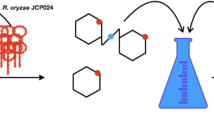Abstract
Growth and sporulation of Verticillium lecanii on inert and organic carriers (sugar-cane bagasse, corncob, rice straw, polyurethane foam and activated carbon) in a solid-state fermentation process was studied. Sugar-cane bagasse and polyurethane foam produced 1010 spores g−1 dry carrier whereas corncob, rice straw, and activated carbon yielded, respectively 8 × 109, 4 × 109, and 3 × 108 spores g−1. Chitinase activity of the conidia was in the following order: sugar-cane bagasse (3.3 U mg−1) > wheat bran (3.0 U mg−1) > polyurethane foam (2.7 U mg−1). There was no significant difference (2.5–2.7 U mg−1) in the proteinase activity among the conidia from the three cultures. Scanning electron microscopy shows that aerial mycelium freely penetrated into the internal area of polyurethane foam. Sugar-cane bagasse provided enough area for vegetative hyphae to attach. Of the carriers analyzed, polyurethane foams and sugar-cane bagasse were the best carriers for V. lecanii growth and spore production.




Similar content being viewed by others
References
Askary H, Carrtere Y, Belanger R (1998) Pathogenicity of the fungus Verticillium lecanii to aphids and powdery mildew. Biocontrol Sci Technol 8(1):23–32
Hallsworth JE, Magan N (1995) Manipulation of intracellular glycerol and erythritol enhances germination of conidia at low water availability. Microbiology 141:1109–1115
Hölker U, Lenz J (2005) Solid-state fermentation—are there any biotechnological advantages? Curr Opin Microbiol 8:301–306
Jackson CW, Heale JB, Hall RA (1998) Traits associated with virulence to the aphid macrosiphoniella sanborni in eighteen isolates of Verticillium lecanii. Ann Appl Biol 10(16):39–48
Kazmierczak P, Kim DH, Turina M et al (2005) A hydrophobin of chestnut blight fungus, Cryphonectria parasitica, is required for stromal pustule eruption. Eukaryot Cell 4(5):931–936
Marin-Cervantes MC, Matsumoto Y, Ramırez-Coutino L, Rocha-Pino Z, Viniegra G, Shirai K (2008) Effect of moisture content in polyurethane foams as support for solid-substrate fermentation of Lecanicillium lecanii on the production profiles of chitinases. Process Biochem 43:23–32
Sarhy-Bagnon V, Lozano P, Saucedo-Castaneda G, Roussos S (2000) Production of 6-pentyl-α-pyrone by Trichoderma harzianum in liquid and solid-state cultures. Process Biochem 36:9–103
Shi YJ, Xu XQ, Zhu Y (2009) Optimization of Verticillium lecanii spore production in solid-state fermentation on sugar-cane bagasse. Appl Microbiol Biotechnol 82:921–927
Acknowledgment
This work was supported by a research grant from the Science and Technology Department of Zhejiang Province, China (2007C24016).
Author information
Authors and Affiliations
Corresponding author
Rights and permissions
About this article
Cite this article
Xu, X., Yu, Y. & Shi, Y. Evaluation of inert and organic carriers for Verticillium lecanii spore production in solid-state fermentation. Biotechnol Lett 33, 763–768 (2011). https://doi.org/10.1007/s10529-010-0496-1
Received:
Accepted:
Published:
Issue Date:
DOI: https://doi.org/10.1007/s10529-010-0496-1




